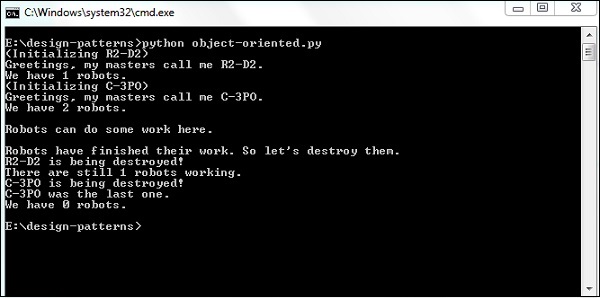📌 相关文章
- 面向对象的C++(1)
- 面向对象的C++
- 面向对象的Python库
- Python 3-面向对象
- Python面向对象(1)
- Python面向对象
- 面向对象的Python库(1)
- Python 3-面向对象(1)
- 面向对象 |面向对象设计(1)
- 面向对象|面向对象设计(1)
- 面向对象 |面向对象设计
- 面向对象|面向对象设计
- 面向对象的方法
- 面向对象的方法(1)
- R面向对象的编程
- R面向对象的编程(1)
- js是面向对象的 - Javascript代码示例
- Ruby-面向对象
- Ruby-面向对象(1)
- Python中的面向对象测试
- Python中的面向对象测试(1)
- 如何测试面向对象 (1)
- matplotlib 面向对象 - Python (1)
- 面向对象的Python文件和字符串
- 面向对象的Python文件和字符串(1)
- 面向对象的Python教程
- 面向对象的Python教程(1)
- 面向对象的Python简介
- 面向对象的Python简介(1)
📜 面向对象的概念实现
📅 最后修改于: 2020-11-07 09:09:41 🧑 作者: Mango
在本章中,我们将重点介绍使用面向对象概念的模式及其在Python的实现。当我们围绕语句块设计程序时,这些语句块围绕函数操作数据,这称为面向过程的程序设计。在面向对象的编程中,有两个主要的实例,分别称为类和对象。
如何实现类和对象变量?
类和对象变量的实现如下-
class Robot:
population = 0
def __init__(self, name):
self.name = name
print("(Initializing {})".format(self.name))
Robot.population += 1
def die(self):
print("{} is being destroyed!".format(self.name))
Robot.population -= 1
if Robot.population == 0:
print("{} was the last one.".format(self.name))
else:
print("There are still {:d} robots working.".format(
Robot.population))
def say_hi(self):
print("Greetings, my masters call me {}.".format(self.name))
@classmethod
def how_many(cls):
print("We have {:d} robots.".format(cls.population))
droid1 = Robot("R2-D2")
droid1.say_hi()
Robot.how_many()
droid2 = Robot("C-3PO")
droid2.say_hi()
Robot.how_many()
print("\nRobots can do some work here.\n")
print("Robots have finished their work. So let's destroy them.")
droid1.die()
droid2.die()
Robot.how_many()
输出
上面的程序生成以下输出-

说明
此插图有助于说明类和对象变量的性质。
-
“人口”属于“机器人”类别。因此,它称为类变量或对象。
-
在这里,我们将总体类变量称为Robot.population,而不是self.population。